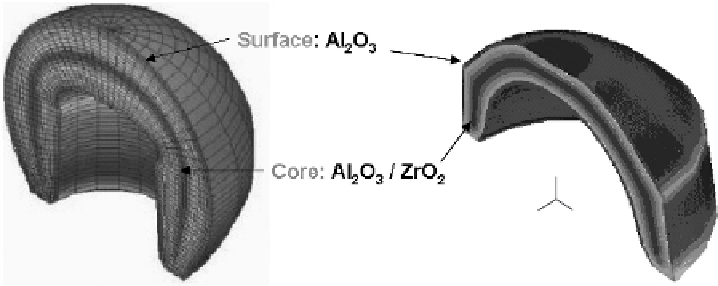Biomedical Engineering Reference
In-Depth Information
2004]. A review of the coatings commercially available for metal-PE joints has
been given by Piconi et al. (2004).
A procedure often adopted for commercial hip joint implants is to coat parts
of the metallic femoral stem by a porous hydroxyapatite coating in order to
improve the bonding between implant and bone. This is usually done by plasma
spraying; see L. Sun et al. (2001) for a review. Other ceramics and coating methods
are being investigated.
10.3.5 Functionally Graded Ceramics for Hip Components
The concept of functionally graded materials (FGM) originates from the observa-
tion that many components only need to posses a certain property locally while
elsewhere another often irreconcilable property is required by the design. To
increase the strength of ceramic ball-heads, the concept of functionally-graded
materials can be used to develop ceramic Al
2
O
3
/ZrO
2
graded composites. The
potential of this bioinert system follows from the properties of Al
2
O
3
(low wear
rate, high hardness) and ZrO
2
(high strength, high toughness).
Due to the difference in thermal expansion coeffi cient of Al
2
O
3
and ZrO
2
,
residual stresses are developed during cooling from the sintering temperature,
which can strongly infl uence the mechanical properties like strength and tough-
ness. Compressive surface stresses in the outer alumina layer will have a benefi -
cial effect on the wear resistance [Katti, 2004].
The design of the composition gradient has to be in such a way that it gener-
ates compressive stresses at those places that are loaded under tensile stress. To
obtain a benefi cial effect on the strength and tribological properties of the com-
ponent, compressive stresses at the surface of the component have to be gener-
ated. A correct design of the gradient from the point of view of thermal stresses is
therefore of primary importance [Toschi et al., 2003; Gasik et al., 2003].
Figure 10.2 shows the concept of FGM ball head, which has been investigated.
Note that all outer surfaces of the ball head as well as the acetabular cup consist of
a mm thick layer of pure alumina. The zirconia is only present in the interior and
is not exposed to the environment so that LTD will not be an issue.
2
3
1
Figure 10.2.
Schematic of an Al
2
O
3
/ZrO
2
FGM ball-head and liner. [Anné, 2005a].

Search WWH ::

Custom Search